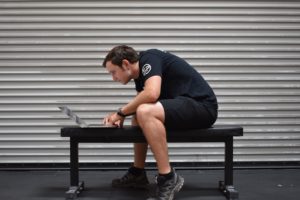
Are you someone who is suffering or has suffered from sciatica? Believe it or not, sciatica is a very common diagnosis with those suffering from low back pain. It is also a term that is thrown around and frequently misdiagnosed, so that is why it is important to have an understanding of exactly what sciatica is and how you can combat the symptoms. Sciatica is a term for when the sciatic nerve gets “pinched.” The sciatic nerve runs from your low back, through your glutes, hips and down the back of each leg. The term “sciatica” arises when this nerve gets pinched or compressed creating radiating nerve pain down the path of the nerve. It is NOT just lower back pain. This pain can be sharp, dull, tingling or numbness. Even though this is a nerve issue, physical therapy can be very beneficial and there are things you can do on your own. If you are someone who is experiencing sciatica, here are four easy ways to ease your pain and calm down that sciatic pain!
1. Improve hamstring and hip flexibility – with lower back pain and sciatica, it is very common to have decreased hamstring and hip flexibility. These two tight structures can lead to increased pressure in your low back and along the path of the sciatic nerve. When trying to improve mobility in your hips and hamstrings, it is important to consider the position of your lower back as you are stretching. Again, you don’t want to place yourself in a position that puts extra stress on that area. Some good examples of stretches are: lying on your back using a strap to stretch your hamstring, bring a single knee or both knees to your chest or a figure-4 stretch.
2. Increase core strength – any time you are experiencing pain in your low back, you need to incorporate core strength into your routine. Understanding how to engage your core is another way to take pressure off of your lower back and improve your stability of the spine. A lot of people go straight to sit-ups as the primary way to work core, but there are actually plenty of options that do not require twisting or bending. For example: planks, Pallof punches and bird-dogs.
3. Avoid prolonged positions – if you can picture how the nerve runs from the low back down through the back of the leg, you can picture how the nerve gets tugged on or irritated with prolonged positions – especially sitting. When you sit for a long period of time, your hips get tight, your lower back becomes tired and this eventually leads to poor posture. This slouched, seated position will aggravate the sciatic nerve, especially if it is already flared up. It is best to change positions every 10-15 minutes if possible.
4. Keep moving – this goes hand in hand with the previous tip. Your spine and entire body was made to MOVE! You don’t want to be in the same position for too long. You actually want to do low impact aerobic exercise – walking especially. The amount of time you want to be active and walking will vary depending on each person’s current level of endurance, so start slow if you are concerned. Maybe walk 5-10 minutes and see how your body reacts the next day and progress as needed. An important thing to not is you do want to avoid steep inclines and declines due to the change in hip position this requires – so stick with level, flat surfaces first.
As always, we hope this helps! If you have any questions or if you would like to read about certain topics, feel free to send us an email at TeamSP@SportsPerformancePT.com.
-Dr. Melanie

P.S. If you’re experiencing stiffness or pain in your back which restricts your ability to move without sciatica, CLICK HERE to download our free sciatica relief guide which includes actionable tips we give to our clients at Sports Performance. Click here to get your free copy: https://www.sportsperformancept.com/sciatica/.
STAY CONNECTED
Instagram: CLICK HERE
Facebook: CLICK HERE
YouTube: CLICK HERE
Podcast: CLICK HERE
TUNE IN TO OUR PODCAST













